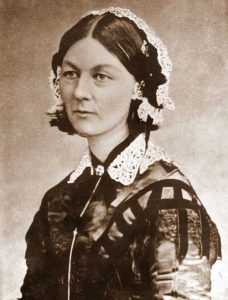 Did you know that the first healthcare architect was a nurse?
Did you know that the first healthcare architect was a nurse?
Okay, it may be a bit of a stretch to call Florence Nightingale an architect, but I was reminded of her impact on hospital design as I read the first chapter in the book, Nurses as Leaders in Healthcare Design, edited by Jaynelle Stichler and Kathy Okland.
In that chapter, Stichler and Terry Zborowsky present a detailed account of Nightingale’s life and her influence on hospital design.
About Nightingale’s arrival at the British hospital barracks during the Crimean war in 1854, they write: “Observing the deplorable conditions and the effect on wounded soldiers’ physical and emotional status, Nightingale demonstrated significant leadership and courage, making changes in the environment to support healing and prevent infections.”
Several years later, in Notes on Nursing, Nightingale presented her ideas on the need for sanitation, hygiene, clean water, light, fresh air, etc. All elements, as Stichler and Zborowsky point out, form the framework of today’s healing environments.
So, not only was she the first healthcare architect, Nightingale was also the mother of healing environments.
More Facts on Florence
Here are some other fun facts about Nightingale from the book chapter:
- She was born in Florence, Italy, to wealthy parents
- A trained statistician and epidemiologist, she was the first to document the morbidity and mortality data of wounded British soldiers
- She wrote more than 200 reports and books and was recognized for her expertise in nursing, hospital administration, hospital design, statistics, epidemiology, nursing education, school administration, military healthcare, and healing environments
- Serving in the Crimean war, she acquired a chronic illness
One more fun fact that I came across recently is that in the years following her return from Crimea, Nightingale is estimated to have written more than 13,000 notes and letters. She would have loved email.
If you’re interested in reading some of those notes and letters, check out the Florence Nightingale Digitation Project, which has created a free, searchable online database of 1,900 items. Hospital design and construction is one of the search categories.
Note: This post was first published May 20, 2016.
P.S. Please do me a favor — if you liked this post and like this blog, please share it with others by sending them the link and/or post it on your Twitter, LinkedIn, or Facebook, etc. Also, don’t forget to subscribe so you’ll get emails when new content is posted. Thanks!
If you like this post, please share.

What’s my story? I’m a healthcare and senior living design knowledge expert who writes and speaks frequently about trends and issues affecting these two industries. I’m also a strategic marketing consultant and content creator, working with companies and organizations who want to improve the quality of healthcare and senior living through the design of the physical environment. You can reach me at sara@saramarberry.com.


4 Responses
I was aware of Florence Nightingale’s creation of healing environments since my first profession was a registered nurse and we studied her briefly in college to set the stage for patient care. However, it is always good to be reminded of those who came before us and bravely worked to establish standards of care.
Nightingale was truly amazing, wasn’t she?
I love reading about Florence Nightingale, because she was not only the founder of nursing, but also the first to address the important of “good” design on patient outcomes. I have come to appreciate her work more as my own career has moved into research and using evidence (both research and non-research) to guide design decisions. Nightingale was a tremendous statistician and remains today, the first woman statistician recognized by the American Society of Statisticians! She emphasized the need to measure outcomes of what we do in nursing and in healthcare design. My mantra has become, “if it is worth doing, it is worth measuring”. I have now added one other component to this personal mantra – “if it is worth doing, it is worth measuring, and it is worth disseminating your findings to guide others in their design decisions”. So, when you measure the effect of your designs on care providers, patients and families, and organizations, please share your findings in HERD Journal, the Healthcare Design Conference, or with the Center for Health Design’s knowledge repository. We need evidence that what we do works (or not) before we replicate the design in other hospitals.
Sara, thank you for recognizing Florence Nightingale once again. She is a role model for us all!
Thanks, Jan! Sharing findings is critical to moving the healthcare design industry forward.